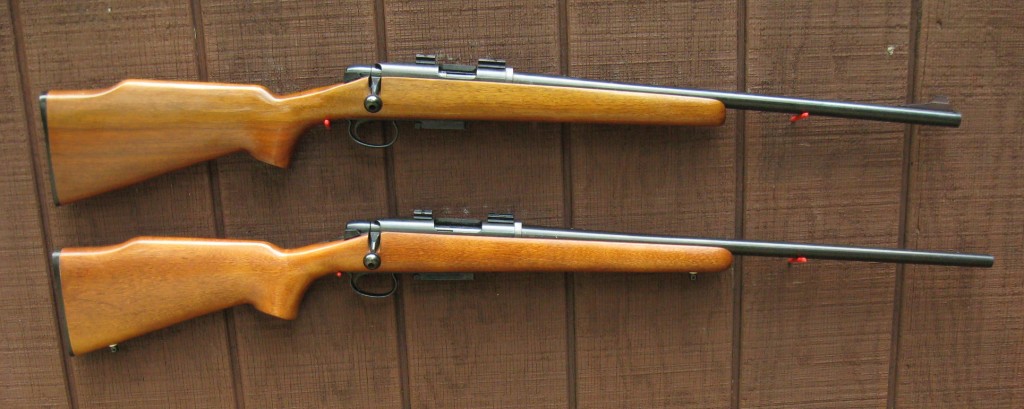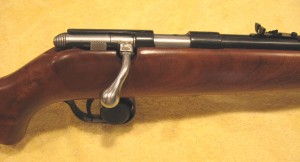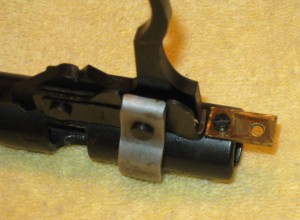Firearms history chronicles the greatness of America. In America from day one, any person who has wanted or needed to hunt could hunt wild game. In the Europe of the people who settled this country, the only hunters were the royalty or members of the nobility. They owned all of the land and had all of the guns. It was illegal for anyone who was not among the gentry to even own a gun. Anyone else who attempted to hunt was deemed a poacher and subject to severe punishment. Imagine the feelings of those who had been thus oppressed when they surveyed the limitless expanse of fish and game country that spread before them in America. It must have been very heartening for settlers in an era when survival was always an issue.
The freedom of all to hunt, and its corollary of gun ownership, is a noble tradition in American history and rest assured, it is not simply one among many freedoms, it is the primary American freedom, and as such, it must be cherished, respected, and protected. There are some people today who fancy themselves members of a ruling class, and who, like the princes, dukes, and earls of old, would like to tell us in the peasantry how to behave. They enjoy enumerating for us all of the things we really don’t need to do, according to their lights, and hunting is one of those things. It can only be seen as an assault on American freedom.
In royal Europe, hunting arms were often ornate to the point of great art, but in a new country in which anyone could hunt, it was necessary to have arms that anyone could own. The earliest guns were brought from abroad, but affordable rifles, that is, plain rifles, became a priority in American manufacturing from earliest times. A great many were made for trade with native Americans, as well as for use by the settlers and the early military establishments. While the first were made by hand in small shops, over a period of time arms production stimulated American industry in general, and introduced many manufacturing innovations, including the practice of machine fabrication and the development of construction with interchangeable parts.
The practice of producing economical hunting arms has continued to the present day. Survey the catalog pages of the Gun Digest and you will find several makers who offer rifles in the $300-400 price range. These are the ones that qualify as plain rifles in today’s market. In these current times of economic stress, perhaps the plain rifle is as important as ever in getting folks into the game fields. One thing is certain, however, the buyer of a plain rifle today can expect very good functionality and performance in the field, a result of manufacturing methods both precise and economical.
My Favorite
In recent history there have been a number of very effective plain rifles. For my money, the queen of the Plain Rifles is the Model 788 Remington. It was produced from 1963 to 1987 in a range of popular calibers, including a couple of rimmed cartridges, the .30-30 Winchester and the .44 Remington Magnum. In developing the
788, Remington did an amazing thing. They didn’t simply cheap down their successful, upscale Model 700. Rather, they designed a whole new action. The outstanding feature of the action is the lockup, which is accomplished by nine lugs (three sets of three) located at the rear of the bolt. This allows a short bolt throw and a fire control design that gives a very fast lock time.  The receiver is heavy-duty tubular steel with a relatively small ejection port cutout. This gives the action great rigidity and contributes to accuracy. In general, the 788 would be classified as a short-action arm. However, and this is incredible, Remington varied the action length to match the caliber of the arm. Among 788s I have examined, the .44 Magnum action measured 5-5/8 inches, the .222 Remington, .22-250 Remington, and .30-30 Winchester measured 6-5/16 inches, and the .243 and .308 Winchesters measured 6-9/16 inches. The 788’s metal furniture was stamped, in the interest of economy, but take a look at the trigger guard shown in the figure. While it is a stamping, it is fabricated with a slight curve around its long axis, which gives it just
The receiver is heavy-duty tubular steel with a relatively small ejection port cutout. This gives the action great rigidity and contributes to accuracy. In general, the 788 would be classified as a short-action arm. However, and this is incredible, Remington varied the action length to match the caliber of the arm. Among 788s I have examined, the .44 Magnum action measured 5-5/8 inches, the .222 Remington, .22-250 Remington, and .30-30 Winchester measured 6-5/16 inches, and the .243 and .308 Winchesters measured 6-9/16 inches. The 788’s metal furniture was stamped, in the interest of economy, but take a look at the trigger guard shown in the figure. While it is a stamping, it is fabricated with a slight curve around its long axis, which gives it just 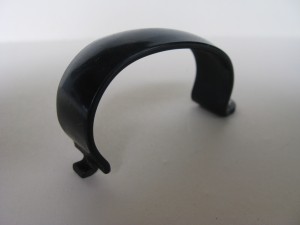 the right appearance. The stock also has a pleasing appearance and is well designed, but of course, no fancy wood or checkering. Upon its appearance in the marketplace, the Model 788 passed tests for accuracy and function with flying colors, and was generally received with praise by shooting journalists. They liked its short bolt throw, crisp trigger, and fast lock time. Over the years it has garnered and maintained a reputation for accuracy in all of its chamberings (1), and that is what has really earned the 788 a place in the hearts of its users, and in history.
the right appearance. The stock also has a pleasing appearance and is well designed, but of course, no fancy wood or checkering. Upon its appearance in the marketplace, the Model 788 passed tests for accuracy and function with flying colors, and was generally received with praise by shooting journalists. They liked its short bolt throw, crisp trigger, and fast lock time. Over the years it has garnered and maintained a reputation for accuracy in all of its chamberings (1), and that is what has really earned the 788 a place in the hearts of its users, and in history.
So, if you have a hankering for a vintage Remington rifle, but white-line spacers make you want to puke, a Model 788 just might be for you. You will need to find a used one, of course, and when you do you just might find that it performs so well that you want it to be a little spiffier. That has always happened to me and I can’t help it. My native frugality urges me to buy something inexpensive, and then I want it to look and perform like one of the pricey elites. Sometimes it doesn’t work out, but it is always fun to try.
I can profess only very amateur standing as a gun craftsman, but I am patient and willing to study and to carefully try things. I think anyone with those characteristics can do at least as well as I have with simple tools at home. That is the point because professional gun work is expensive. I will say, however, that if you have a reputation for being impatient, or of not being handy, perhaps even of being all thumbs, then proceed with caution. Maybe just handload for and enjoy shooting your plain rifle, or have someone else do the work to preserve your investment. Maybe, but I advise trying something, and start with simple things. And observe the Cardinal Rule : Have no live ammunition in your work area!
What You Can Find
The Model 788 is not rare in the used marketplace, but its numbers have thinned in recent years. A couple of examples are shown in the first picture above. If you are fortunate you might find one with a walnut stock but it is much more likely that you will encounter examples with hardwood stocks. I don’t have information on the production numbers of each but I believe that walnut stocks were confined to the earlier years of production, and make up a small minority of the total. Usually, the original box will not be present, and the original open sights might also be absent. A scope is often attached to the offering, but if not, bases by Weaver and others are readily available for mounting your own. In some cases, you may end up paying more than it would take to get a brand new edition of one of the current generation of plain rifles. Doesn’t bother me, because I really like the 788.
A Modest Example: Model 788 .30-30 Winchester
One of my favorites is a Model 788 in .30-30 Win. Count it a good day at a gun show when you find one of these. Many feel that this is the most accurate rifle ever made in the .30-30 caliber. Mine has a low serial number and a walnut stock. It grouped well from the beginning, about as well as one would expect from an economical .308 or .30-06, and working up accurate handloads presented no problems. As this transpired, I anticipated that I could coax some outstanding performance and along with that should come a little nicer appearance.
The appearance work included fitting a steel grip cap, cutting sheet brass spacers for the grip cap and buttplate. The rough cut was made with a scroll saw and a thin, metal-cutting blade. Using the butt plate as a template, I worked the brass to size with a file, then
polished the edges with abrasive paper. I then filed and sanded a thumb flute in the comb, and refinished the stock. That included removing old finish, filling pores, and applying a good grade of 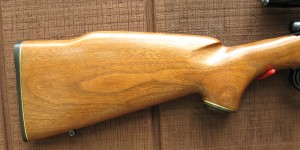 polyurethane varnish. I like semi-gloss, but you might like satin. At any rate, use a spray can and light coatings, several times. It is a great way to go, and the finish is very durable.
polyurethane varnish. I like semi-gloss, but you might like satin. At any rate, use a spray can and light coatings, several times. It is a great way to go, and the finish is very durable.
About the time I picked up his rifle I also got interested in glass bedding rifle actions in stocks. Better support of an action usually promotes accuracy. The receivers of Model 788s are round on the bottom, but they are fairly easy to bed. I used Acra-Glas Gel from Brownell’s (2) and I bedded the recoil lug area, a little area behind the recoil lug, about 3 inches of barrel channel in front of the recoil lug and the tang area. It is possible to do this all in one gooey session, or you could do the recoil lug area and the tang area in separate sessions. I have done it both ways with different rifles. Usually there is no problem with bedding
all in one session, if you can keep your cool. The Acra-Glas really takes a fairly long time to set up. You can see in the picture that I installed a pillar for the front action screw and that the barrel is floated ahead of the bedding. The rifle is a joy to shoot. The bedding treatment really brought accuracy into focus, and I can fire many rounds of the mild .30-30 in range sessions without getting punchy. The rifle regularly shoots sub-minute-of-angle groups at 100 yards with good handloads, and consistent performance from day to day is the rule.
An Immodest Example
One of the first Model 788s that I worked with was chambered for the .308 Winchester. Its performance was good, and probably would have satisfied anyone in deer country, but it was not quite up to my expectations, which were based on the reputations of both the .308 cartridge and the 788 for accuracy. I went through a number of accuracy tweaks, including floating the barrel, trying barrel pressure at the end of the stock, and stabilizing the action in the stock with shims. In the end, glass bedding again proved to be the way to insure accuracy both fine and consistent. Good handloads were no problem with the non-tempermental .308, and W748 and Varget were used with Sierra and Hornady bullets. While working on accuracy, I happened to find some cherry veneer in a lumber yard and got curious about using it to dress up the hardwood stock. Results of applying some cuts of this material to the foreend and butt are shown in the pictures. The hardwood stock was treated with ebony stain and
then the cut cherry pieces were applied with urethane glue (the cherry pieces were not inletted in the original wood, maybe next time). Using rubber tubing to hold the veneer in place while the glue dried worked pretty well. Then the whole got a finish of polyurethane varnish. Before finishing, I reshaped the grip a bit and then I jeweled the forward (visible) section of the bolt to finish up.
The result turned out well in terms of craftsmanship, and has been very durable, but I am not sure I would want to be caught out in the deer woods with “Mr. Cherry Cheeks.” I think someone with more artistic talent than I might find some possibilities here. The gun does attract a bit of attention at the range, but catcalls are suppressed when his groups turn out to be as good or better than those of others shooting various thirties at the bench. At any rate, I have a black plastic RamLine stock which this rifle can wear for formal occasions.
Autobody Gun Work: A Model 788 .22-250
On a trip to an auto parts store one day I happened to notice in the paint section a can of, WOW!, a can of walnut metallic automotive lacquer. That’s right, walnut metallic. (3) At the time I was wondering what to do with a Model 788 in .22-250 caliber that shot very well, but had a hardwood stock that was plain, plain, plain. I knew that showy shooters in the bench rest game had been giving their rifles snazzy paint jobs for some time, so the spray can went home with me.
Very shortly I removed the old stock finish and filled the pores with several coats of spar varnish, worked down with steel wool between coats. Didn’t know what else to do so that is what I did, and the result was super smooth. Then came a number of light coats of the walnut lacquer (spray), followed by a top coat of clear lacquer. The color was a wonderful red-brown, very deep with silver flecks floating in it. It looked like six million bucks! I could have hung it on the wall and admired it for many years. Alas, on the very first trip to the range, in spite of careful handling, small flakes of the finish started to come off. After a couple more shooting outings, it was clear that the finish had poor adhesion and would have to go.
Back at the workshop I stripped the lacquer and then applied a base coat of automotive primer. I let it cure for a week and it seemed sturdy. Several coats of the walnut metallic finish then went on as before. It looked good, but unfortunately did
not have quite the depth or vibrant color of the original job. It has, however, turned out to be much more durable and that is a plus. More durable does not mean, however, that you would want to put it behind the seat of the pickup. This rifle also got a steel grip cap, brass spacers for the metal parts, and the visible bolt area was jeweled as with the .308.
Owing to the inherent accuracy of the .22-250 cartridge and the careful bedding of the action, this rifle is an outstanding shooter.
Back in Time: A Harrington and Richardson Single Shot .22
Some of my early shooting experiences involved arms manufactured by the firm of Harrington & Richardson, and so I have a soft spot in my heart for this old, plain-gun producer. The firm operated from 1871 to 1986, largely in Worcester, Massachusetts. H&R gained a reputation for sturdy, utilitarian, affordable guns that rarely got any respect from the discriminating folks in the firearms press. Perhaps best known for hordes of inexpensive revolvers, H & R also made rimfire rifles, centerfire rifles, shotguns, and military arms under government contract. Sprinkled among the many diverse offerings are a few gems which deserved a bit more admiration than they got, but that is another story.
The H & R to be discussed here is the Model 750, a single-shot, .22 rimfire rifle also known as the “Pioneer.” It is a typical, bolt action .22 single-shot with no outstanding
features, although it has a walnut stock and not even one little plastic part, except for the butt plate. I believe it was made in the 1950’s, consistent with the fact that it does not have the abominable dovetail grooves in the receiver that newer .22s have for scope mounting. Informal range work showed that the rifle was capable of good accuracy, and so I wanted to encourage this and also dress the gun up a bit.
Here is what I did: Inletted the trigger guard, filed a thumb flute in the comb, refinished the stock with a good coat of polyurethane, made a brass spacer for the buttplate, glass bedded the action in the stock, which included glassing three inches of the barrel channel ahead of the action screw, putting a pillar in the action screw hole, and bedding the rear tang of the action. This last received special attention because there is not much to bed in the rear area. To remedy that, I fashioned a small metal plate, drilled and tapped to attach the plate to the end of the tang with a small
screw, and then glass bedded the plate into a recess cut in the tang area of the stock. An additional screw secures the tang plate to the stock. The pictures should make the process clear. The result is an action that is extremely well supported in the stock both fore and aft.
It is fair to ask “Why go to all of this trouble with a cheapie?” Part of the answer is that I like to experiment and, as earlier stated, I get a kick out of improving something plain. I am always encouraged by the fact that, in my experience with plain rifles, I have found that
barrels, even with inexpensive .22s, are usually expertly bored and rifled, and therefore capable of very good accuracy, but the method of supporting the action and barrel in the stock did not get enough attention and falls short of insuring very good performance.
The modified H&R Pioneer is a good looker and shooter, but I have trouble finding its best performance because of the open sights, hard to see clearly at this time in my life. I have had 5-shot groups in the range of ¾-inch at 50 yards, but I am sure the rifle can do a bit better. I am investigating ways of mounting an aperture sight as that would make a big difference.
What To Do Next: A Model 788 Carbine .243
Projects are never in short supply. The only problem is choosing a good one to work on. The next one involved the .243 carbine shown in the picture.
What did I do with it? Hint: The original stock is too long. Remington 788 carbines had 18-inch barrels, but apparently full rifle stocks were used, so the proportion ended up looking a bit odd. I really do not understand what Remington was thinking, so I got my tools and went to work.
First off, I sawed an appropriate length off the end of the forearm. Then I went to work with wood rasps, files, and sandpaper. No
templates or measurements, just buzzed away until I thought it looked right. You can judge. One thing I will say, creating a schnabel foreend is a challenge for a duffer. Like all my gun work, I can say, “next time I will do better.” And I will need to refinish the whole stock to make it look acceptable.
I think the finished product looks good, and the handling is superb. Unlike some other carbines, the barrel is not a whippy little wisp. I like that because it gives the gun better balance. I haven’t done much shooting with this rifle, but I will, and I will let you know how that comes out.
And now, for the next project……..
(1) Calibers, not all available at the same time, were .222 Remington, .223 Remington, .243 Winchester, 6 mm Remington, 7-08 Remington, .30-30 Winchester, .308 Winchester, and .44 Remington Magnum (Yep, .44 Mag!).
(2) Acra Glas Gel, and other bedding products, can be found at www.brownells.com/
(3) Plasti-kote FM 8113

